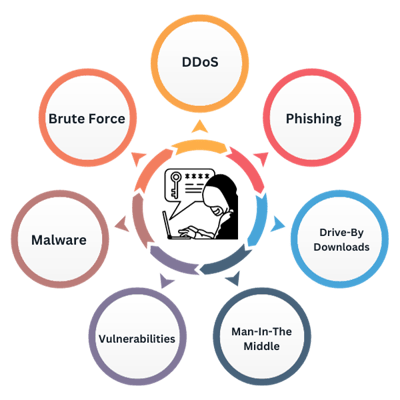Understanding your adversary is crucial when it comes to cybersecurity. By the end of this post we hope you will comprehend different attack vectors in greater detail and lay out practical protection tactics before an attack occurs.

What Are Attack Vectors?
Attack vectors are the routes or strategies that cyber-criminals use to break into networks. phishing emails, malware, software flaws, drive-by downloads, and man-in-the-middle assaults are a few common examples.
Phishing Emails
Phishing emails pose as legitimate communications from reliable sources in an effort to dupe recipients into disclosing personal information or downloading malware.
Usually sent in bulk, these emails often contain urgency or appeal to authority to lure the recipient into action.
By monitoring email traffic for known phishing signatures and suspicious behavioral patterns, MDR provides an additional layer of security.
Malware
Malware refers to a broad category of harmful software that is intended to interfere with, harm, or allow unauthorized access to computer systems. Typically installed using misleading links or malicious software installers. Ransomware is the most prevalent type of malware seen today.
MDR scans files and network traffic for known malware signatures and isolates compromised systems to prevent further spread. We even have a module dedicated to managing ransomware risks.
Software Vulnerabilities
Hackers can use these code mistakes or oversights in software to obtain unauthorized access. It operates by delivering prepared commands or inputs that the software wasn't built to process safely. MDR’s proactive vulnerability scanning helps identify security gaps in your software stack, increasing your resilience to attacks.
Brute Force
In order to gain unauthorized access to a system, brute force assaults require continually attempting to guess login credentials. They work by either using a list of frequently used passwords or by methodically attempting all potential combinations.
MDR can detect persistent failed login attempts and recommend multi-factor authentication or block the user's IP address until their identity is confirmed.
Distributed Denial of Service (DDoS) Attacks
DDoS assaults overburden a network, server, or website with unreasonably high traffic in order to make it unavailable. They work by using a botnet, or network of hijacked computers, to flood the target with requests.
In order to maintain system availability, MDR can track traffic patterns in real-time, spotting unusual spikes and enacting traffic filtering or rate restriction.
Drive-By Downloads
Automatically install malicious software on a user's computer when they visit a website that has been compromised. They typically operate through malicious scripts embedded in websites.
MDR can prevent access to websites known for hosting malware or enable real-time scanning of downloaded files.
Man-In-The-Middle Attacks
Intercept two parties' conversations in order to eavesdrop or pretend to be one of them. This is frequently achieved by taking advantage of unsecure Wi-Fi networks or by infecting network hardware with malware.
MDR solutions can automatically block suspicious IP addresses and track network traffic patterns for anomalies that can point to an attempt at interception.
Why Is MDR Your Best Defense Strategy?
- Real-Time Monitoring
MDR provides 24/7, round-the-clock monitoring to make sure you are always safe.
- Expert Evaluation
MDR can effectively identify even the most complex assaults by combining human expertise and AI machine learning analytics.
- None or Very Few False Positives
You can focus on your business while MDR expert human analysts validate all alerts so you only get notified when something needs your attention.
- Quick Reaction
MDR offers quick response to contain attacks, from firewall updates to network isolation.
- Regulatory Compliance
Supports compliance with regulations like GDPR, HIPAA, or PCI-DSS.
Cost-Benefit Analysis
Although the initial cost of MDR may seem high, the consequences of being a cyberattack victim could be disastrous. MDR reduces these risks, which has long-term positive financial and operational effects. Get a quote and see how much you could save.
Conclusion
Your cybersecurity posture can be significantly enhanced by comprehending the workings of various attack vectors and how MDR offers specialized defense mechanisms.
Don't expose your network to risk. Take action right now and learn more about ForeNova's MDR solution.
FAQs
Q: What is an attack vector, exactly?
A: A planned series of techniques that a hacker employs to get around security protections.
Q: How does MDR protect against various attack vectors differently?
A: MDR adapts its security methods to each assault vector using a combination of real-time monitoring with AI machine learning and behavior analytics combined with expert, human investigation.
Q: Is it financially wise to invest in MDR?
A: MDR is a smart long-term investment for lasting security, given the serious consequences of a cyberattack.
Q: How can I determine which attack vectors are most pertinent to my industry?
A: Threat modeling provided by MDR solutions identify the attack vectors most likely to have an effect on the infrastructure and industry you are in.
Q: Do MDR systems have the flexibility to respond to new attack vectors?
A: In fact, MDR dynamically evolves to respond to new attack vectors thanks to a combination of globally sourced threat intelligence, machine learning, and expert analysis.
Q: What are the most typical attack vector types?
A: Among the most frequently abused vectors include ransomware, man-in-the-middle attacks, phishing emails, and software flaws.
Q: Do internal threats count as an attack vector as well?
A: Yes, internal threats are considered as an attack vector because intentional, or accidental, incidents can be just as harmful. MDR monitors and helps manage these internal threats.
Q: Are attack routes limited to software or can hardware also be at risk?
A: It is possible to target both software and hardware. Hardware assaults may entail manipulating real-world equipment or taking advantage of firmware flaws.
Q: How can I teach my team to spot potential attack vectors?
A: Employee training modules that teach personnel about seeing and disclosing potential security issues linked to typical attack vectors can be included in MDR services.
Q: Is cloud storage secure against attack methods?
A: Even though cloud storage companies often have strong security safeguards in place, they are not completely impervious to attack methods like account theft or data leaks. For cloud services, MDR can add an additional layer of security monitoring.



.svg)
.svg)





